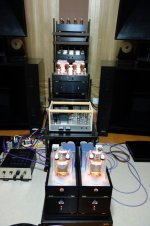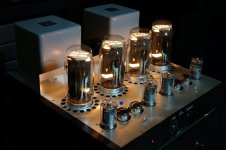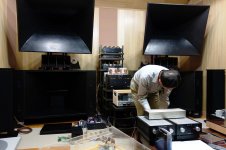Hello sir anatoliy....
Can I ask what is the ideal load impedance for 4P1L Push pull Parallel?
In PSE I think its around 2.5k/8...DO I need to double it Ra-a = 5k?
Can I ask what is the ideal load impedance for 4P1L Push pull Parallel?
In PSE I think its around 2.5k/8...DO I need to double it Ra-a = 5k?
Hello sir anatoliy....
Can I ask what is the ideal load impedance for 4P1L Push pull Parallel?
In PSE I think its around 2.5k/8...DO I need to double it Ra-a = 5k?
I believe Ale measured the plate resistance as 1.6K, so a pair would be 800 ohms by that calculation. So go by the average 300b or 2a3. So 2.5K would be the lowest you'd want to go PSE, but you may want to choose 3K or 3.3K.
Double that for PP, like 5K to 6.6K
THANKS FOR THAT KIND RESPONSE ANDY...I believe Ale measured the plate resistance as 1.6K, so a pair would be 800 ohms by that calculation. So go by the average 300b or 2a3. So 2.5K would be the lowest you'd want to go PSE, but you may want to choose 3K or 3.3K.
Double that for PP, like 5K to 6.6K
Now i know where to use my 5k hifi trafo from an 6AQ5 defunct amp...i have 10 pcs of 4p1l to use for PPP...
It is apparent that transition point from A1 to A2 is at around 5~6W.
Hiro
Class A2 starts from 1.6-1.8W output per tube.
I noticed that the operation point was shifted in 8~10W during the measurement:
Hiro
I.e. the same 7.5W actually. You can't get more from them, even when biased up to 11W dissipation (at the edge of glow)
😕
Wavebourn - are you referring to Hiro's amp?
Jazbo,
In class A1 the grid voltage is always more negative than the cathode voltage while in class A2 the grid is driven more positive than the cathode for part or all of the waveform. Class A2 draws grid current and so requires a driver circuit that can supply power to the grids.
In class A1 the grid voltage is always more negative than the cathode voltage while in class A2 the grid is driven more positive than the cathode for part or all of the waveform. Class A2 draws grid current and so requires a driver circuit that can supply power to the grids.
Dear Ale,
Thank you very much for a chart and detailed analysis of my 4P1L PSE amp.
I performed it in the other channel too.
I noticed that the operation point was shifted in 8~10W during the measurement:
1) Grid bias of 4P1L: -23.1V( 1W), -23.5V(10W)
2) Cathode current of 4P1L: 92.1mA(1W), 99.8mA(10W)
3) Plate current of 7119(CF): 13.1mA(1W), 16.0mA(10W)
Hiro
Hello Hiro,
nice amp as usual from you. I have been thinking for some time to use the same operative conditions for the 4P1L's (i.e. 280V at 25-30 mA each) for a class AB2 amplifier. Ale can tell you this as well because he run some simulations.
In theory it is possible to get 25W into 8R from a parallel push-pull with 2.5K plate-to-plate impedance. The power increases to about 32W if the load from speakers drops to 4R (i.e. same secondary for 1.25K primary impedance). THD should be around 3% in both cases.
THD will be about 1% at 14W for the 8R load and at 10W for the 4R load. From this point distortion with 4R load will increase slower than 8R because of less grid current and 4P1L curves are more linear with lower plate load. This explains why max power output is higher for the same THD with lower plate-to-plate impedance.
Last edited:
Has anyone tried 4p1l driving 45? Seems like it could be a reasonable DHT driver tube, as the others require substantial heat sinking with Rod's filament regs.
Member
Joined 2009
Paid Member
In theory it is possible to get 25W into 8R from a parallel push-pull with 2.5K plate-to-plate impedance. The power increases to about 32W if the load from speakers drops to 4R (i.e. same secondary for 1.25K primary impedance). THD should be around 3% in both cases.
THD will be about 1% at 14W for the 8R load and at 10W for the 4R load. From this point distortion with 4R load will increase slower than 8R because of less grid current and 4P1L curves are more linear with lower plate load. This explains why max power output is higher for the same THD with lower plate-to-plate impedance.[/QUOTE]
Hi,
Thanks for your comment.
Honestly, I am not interested in PP amps for the time being.
On last Sunday, we had an interesting get-together at my friend`s listening room for comparing three amps e.g. a)GM-70 PP(100W), b) 833C SE(70W) and c) mine: 4P1L PSE(10W). The SP system used was of 4Way all horn type and its efficiency was of over 100dB. We (five) had a feeling that there was not significant differences in between concerning to its sound performances, although there must have some personal preferences.
Thanks to the 100dB SP system, I was amazed of its performance with my 10W amp. I believe that it must be attributed to the power requirement for the SP system being sufficient with 0.5~1W, the THD of 4p1L amp is ca.0.76% at 1W and most of which were from H2. Therefore we had a good feeling as far as its sounding in general. As this 4P1L PSE amp is single stage, and no cancelation of H2 occurred with voltage amplifier stage.
Hiro
THD will be about 1% at 14W for the 8R load and at 10W for the 4R load. From this point distortion with 4R load will increase slower than 8R because of less grid current and 4P1L curves are more linear with lower plate load. This explains why max power output is higher for the same THD with lower plate-to-plate impedance.[/QUOTE]
Hi,
Thanks for your comment.
Honestly, I am not interested in PP amps for the time being.
On last Sunday, we had an interesting get-together at my friend`s listening room for comparing three amps e.g. a)GM-70 PP(100W), b) 833C SE(70W) and c) mine: 4P1L PSE(10W). The SP system used was of 4Way all horn type and its efficiency was of over 100dB. We (five) had a feeling that there was not significant differences in between concerning to its sound performances, although there must have some personal preferences.
Thanks to the 100dB SP system, I was amazed of its performance with my 10W amp. I believe that it must be attributed to the power requirement for the SP system being sufficient with 0.5~1W, the THD of 4p1L amp is ca.0.76% at 1W and most of which were from H2. Therefore we had a good feeling as far as its sounding in general. As this 4P1L PSE amp is single stage, and no cancelation of H2 occurred with voltage amplifier stage.
Hiro
Attachments
Hi,
Thanks for your comment.
Honestly, I am not interested in PP amps for the time being.
It was more a comment about grid current than a proposal.
As someone else said you have already reached the maximum possible Pout.
Cheers
Has anyone tried 4p1l driving 45? Seems like it could be a reasonable DHT driver tube, as the others require substantial heat sinking with Rod's filament regs.
4P1L is an excellent choice for driver. In addition to the fact that you can easily implement filament bias (which is more than a plus to me), it's very linear in triode mode. Probably one of the most linear triodes out there. It can also swing many volts and provide very low distortion and nice harmonic profile when swinging 200Vpp.
I did some tests here with transformed coupling:
http://www.bartola.co.uk/valves/2014/02/01/4p1l-driver-ll7903ll1671-tests/
Of course you can DC-couple it and use some sand (e.g. mu-follower) or SRPP and distortion figures will be improved.
Cheers
Ale
On last Sunday, we had an interesting get-together at my friend`s listening room for comparing three amps e.g. a)GM-70 PP(100W), b) 833C SE(70W) and c) mine: 4P1L PSE(10W). The SP system used was of 4Way all horn type and its efficiency was of over 100dB. We (five) had a feeling that there was not significant differences in between concerning to its sound performances, although there must have some personal preferences.
Thanks to the 100dB SP system, I was amazed of its performance with my 10W amp. I believe that it must be attributed to the power requirement for the SP system being sufficient with 0.5~1W, the THD of 4p1L amp is ca.0.76% at 1W and most of which were from H2. Therefore we had a good feeling as far as its sounding in general. As this 4P1L PSE amp is single stage, and no cancelation of H2 occurred with voltage amplifier stage.
Hiro
Hi Hiro,
Great testing system! I'd be keen to hear your feedback about the listening comparison and what was/wasn't liked on the 4P1L PSE amp.
Cheers,
Ale
Of course you can DC-couple it and use some sand (e.g. mu-follower) or SRPP and distortion figures will be improved.
I think it is the time to review the beginning of this thread, where I used cathode follower to drive 4P1L 🙂

Last edited:
Member
Joined 2009
Paid Member
Why go to the trouble of making a cathode follower hollow-state in this design Wavebourn ? - you already have sand here, you could simply use a source-follower.
I think it is the time to review the beginning of this thread, where I used cathode follower to drive 4P1L 🙂

Oh yes, missed that one! Sorry. The way you've done it here is ideal to apply fixed bias.
Why go to the trouble of making a cathode follower hollow-state in this design Wavebourn ? - you already have sand here, you could simply use a source-follower.
It can be done either way. But tubes add less capacitance.
Oh yes, missed that one! Sorry. The way you've done it here is ideal to apply fixed bias.
Yes, the main point was in fixed bias and A2.
...and absence of an interstage transformer. However, clipping is still hard unlike with a transformer, so higher negative voltage (and different mosfet) would serve better.
Last edited:
It was more a comment about grid current than a proposal.
As someone else said you have already reached the maximum possible Pout.
Cheers
Well, I have built this amp on experimental for attaining maximum output within minimal clipping level under stable color of the plate surface.
BTW, the MJ magazine on April issue, Mr. Katsu Nagashima contributed an interesting article about 4P1L tube. He looked into the inside of the tube (one fabricated in Soviet era) and found that there are two getter rings at the top and lots of getter flashed. He assumed to be the top getter is from Barium oxidize getter (due to whitening), however the side getter might be from Magnesium oxidize (stable native color).
Additionally he found the plate was supposedly coated with Zirconium.
He concluded this 4P1L was designed and made on non cost conscious basis but for ultimate reliability.
- Home
- Amplifiers
- Tubes / Valves
- One more 4P1L SE


